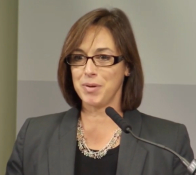National HIE Connection and App Store in ONC Plans for 2016
The national coordinator noted that she continually hears from healthcare providers that they are experimenting with new technologies.

- National Coordinator for Health IT Karen DeSalvo, MD, revealed on Dec. 8 two key initiatives intended to catalyze health information exchange and health IT interoperability initiatives during the coming year.

Speaking at a Bipartisan Policy Center event in Washington, DeSalvo said the Office of the National Coordinator for Health IT would strive to connect public and private health information exchanges (HIEs) nationally by the end of 2016 and develop a “prototype app store” as a central repository for downloadable health IT applications.
DeSalvo likened current HIEs to “information highways” and noted that, in areas such as Maryland, technology structures already extend across state lines. “Our goal is to see that we can connect that highway, including the health information exchanges but also the private sector exchanges, in the entire country within a year,” she stated. “That lays a foundation that we can build upon every year, to add more information to see that it can flow.”
In framing next year’s plans, the national coordinator added that she continually hears from healthcare providers that they are experimenting with new technologies such as the Fast Healthcare Interoperability Resource (FHIR) draft standard for exchanging clinical data. Rather than having apps — which DeSalvo described as “doorways to data” — scattered in many different pockets, providers would like to access them in a central marketplace.
The first step toward that goal, DeSalvo explained, would be two ONC-hosted challenges to determine, for example, “who can come up with the best apps that will give consumers access to their data, [and] give a doctor access to a user interface that’s going to make more sense for them.” The challenges would be designed to “drive the best to the top,” she continued, and feed into an app store — described as the "FHIR Cloud" — to be developed in collaboration with the private sector.
DeSalvo predicted success for these initiatives “in short order” to “meet some of the challenges that we’re facing in health IT — all really to the goal that we’re going to get to this health system that’s going to give us all better care, smarter spending and healthier people in real time.”
Legislative update
Senators Bill Cassidy (R-LA) and Sheldon Whitehouse (D-RI) followed DeSalvo’s remarks with an update on their co-sponsored Senate bill 2141, the Transparent Ratings on Usability and Security to Transform Information Technology (TRUST IT) Act of 2015, which includes a star-based rating program intended to evaluate the field performance of certified health information technology with regard to interoperability, usability and security.
“The problems we’re working through now are the nuts-and-bolts stage of how our IT infrastructure will improve the quality and efficiency of our healthcare system, something we desperately need to do,” said Whitehouse. “Ultimately health IT is about helping patients and their loved ones. There is great potential here to help people get better care and lead healthier lives. There are wins already on the books, and more to come, if we get this right.”
Whitehouse added that he sees “big opportunity for a result” with the proposed legislation due to sharpened health IT focus in Congress. “The slightly disabling political conversation about Obamacare, which virtually prevented any other conversation on healthcare from happening in Washington, has abated,” he explained.
Cassidy pointed out that the House has already passed a version of the bill, which is included in the pending 21st Century Cures Act. “We’re not sure if that as a whole piece will come up for a vote in the Senate. But if not, I will — and I think Senator Whitehouse as well — will push that this would be considered separately. I can’t guarantee that, but that would be our hope,” he noted.
Image credit: Bipartisan Policy Committee
